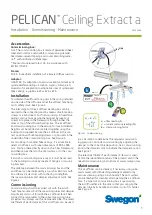
1
Installation – Commissioning – Maintenance
20130806
PELICAN
TM
Ceiling Extract a
Accessories
Commissioning box:
ALS. The commissioning box is made of galvanized sheet
steel and contains a removable commissioning damper,
fixed measurement tapping and sound absorbing mate-
rial*
)
with reinforced surface layer.
*
)
Fire resistance rated to B-s1,d0 in accordance with
EN ISO 11925-2
Frame:
SAR K, for aesthetic installation of a lowered diffuser section.
Adapter:
ADAPTER, for adaptation to various variants and makes of
systemized false ceilings: Ecophon, Gyproc, Dampa, etc.
Used also for adaptation to alternative sizes of systemized
false ceilings, e.g. 625 x 625 or 675 x 675.
Installation
To unfasten the diffuser face, press in the spring retainers
on one side of the diffuser and let the diffuser face hang
on its safety cords. See Figure 2.
The inlet spigot of the air diffuser backing box can be
secured to the connecting duct by means of self-tapping
screws or a blind rivets. For flush-mounting in fixed false
ceiling constructions, secure the terminal by means of
screws into place in the framework through either the
sides or top of the diffuser backing box. The air diffuser
and commissioning box in the version for low installation
height must be centred and jointed together using the
locking strip supplied. Secure the air diffuser in the cor-
rect position with self-tapping screws or pop rivets in the
underside of the commissioning box. See Figure 4.
For mounting in modular false ceilings, it is advisable to
select air diffusers with outer dimensions of 595 x 595
mm. Position these directly down in the T-bar framework,
and then secure them to the duct system or to the com-
missioning box.
If an ALS commissioning box is used, it must be secured
to the building structure by means of hangers or mount-
ing brackets.
The distance between the commissioning box and the
air diffuser can be increased by as much as 500 mm with
an ordinary circular duct without having to lengthen
the measuring tubes and damper adjustment cords. See
Figure 3.
Commissioning
Commissioning should be carried out with the air dif-
fuser face mounted. Pull the measuring tubes and damper
adjustment cords out through the air diffuser face. Then
connect the manometer to the correct measuring tube.
For extract air, always use the transparent tube. The rated
coefficient of performance of the air diffuser can be used
Figure 1. Commissioning
in a calculation to determine the required commission-
ing pressure. Conclude commissioning by adjusting the
damper to the correct blade position, tie a commissioning
knot in the damper cords to indicate the damper position.
See Figure 1.
The rated coefficient of performance (K-factor) is speci-
fied on the identification label of the product and in the
relevant commissioning instructions at www.swegon.com.
Maintenance
The air diffuser can be cleaned, if necessary, using luke-
warm water with dishwashing detergent added or by
vacuum cleaning using a brush nozzle. The duct system
can be reached for cleaning after opening the air diffuser
face. If a type ALS commissioning box is used, swing
the air diffuser face to the side so that you can grip the
damper tube by its handle and rotate it out of its holder.
See Figure 5.
PELICAN CE
Tomelilla
Sweden
200-600
+ALS 160 -200/125 -200
k
k = XX / XX
q
FRÅ
NLU
FT /
EXTR
ACT AI
R
k
p
q
⋅
=
k
p
q
=
( )
2
p
q
= flow reading l/s
p
= current pressure reading (Pa)
k
= commissioning factor
k-factor





















